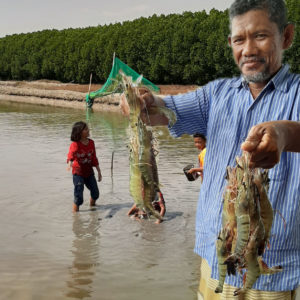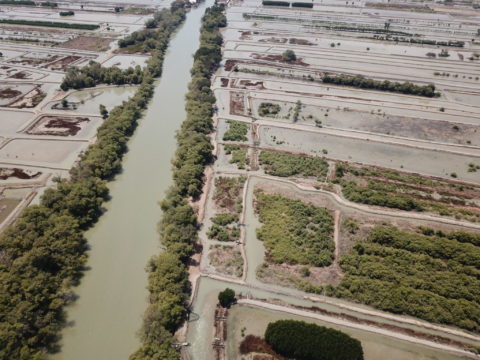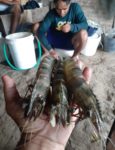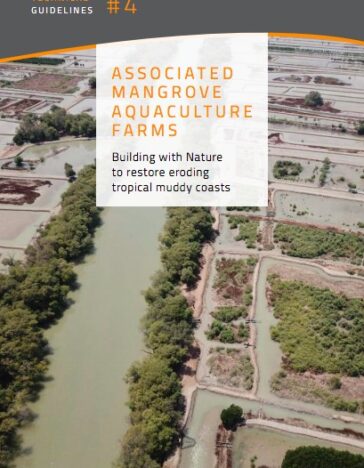Webinar series & guidelines: Creating sustainable mangrove aquaculture landscapes
Date: 02/06/2021 – 16/06/2021
Venue: Online – Zoom
Expanding shrimp aquaculture has been one of the main drivers of the loss of mangrove forests worldwide. Consequently, tropical mud coastlines have become vulnerable to severe erosion and catastrophic flooding. Is it possible to boost aquaculture practices while protecting ecosystems and enhancing climate resilience? Yes it is! Learn more in our upcoming webinar series (2, 9 and 16 June) presenting the results of 5 years of piloting our Mangrove Aquaculture approaches in Demak, Indonesia and in our technical guideline on ‘Associated Mangrove Aquaculture Farms’.
One of the main causes of coastal erosion problems in Demak on the North coast of central Java, is the removal of mangrove belts for aquaculture development. While residents used to make a good living from their aquaculture ponds, today the erosion is flooding their land, houses and ponds. Still, in rural settings, mangrove and brackish water aquaculture can be complementary land-use systems when managed sustainably. When a wide greenbelt is restored, ponds can be revitalised behind the mangroves. The ecosystem functions of mangroves can benefit aquaculture through the dampening of waves and protecting and strengthening the pond dykes. Farmers can also collect wild fry from the mangroves to stock their ponds, and mangrove roots can absorb heavy metals and improve the pond water quality.

Pak Abdul Ghofur, fish farmer and participant in the Coastal Field Schools of the Building with Nature programme in Demak. @Blue Forests
To rebuild a stable and prosperous coastline in Demak, the Building with Nature Indonesia programme, led by Wetlands International in collaboration with local and international partners and the Indonesian government, therefore integrated mangrove and river restoration with sustainable land use. Among others, we introduced a sustainable aquaculture model with space for mangrove restoration and environmentally friendly aquaculture practices.
In close collaboration with local shrimp farmers, we boosted aquaculture productivity and local incomes and increased hazard resilience. Farmers helped design the approaches, were trained on the job through Coastal Field Schools and rooted the measures in community development plans.
Among others, the programme introduced innovative Associated Mangrove Aquaculture (AMA) systems to restore mangrove greenbelts in the estuary along inland waterways and to protect adjoining fishponds. In AMA systems, part of the aquaculture pond is given up to make space for riverine mangroves and as such offers a more sustainable alternative to existing silvo-fishery systems which are often applied in Indonesia, but which do not contribute to coastal protection and may even have negative effects on aquaculture.

Associated Mangrove Aquaculture System in Demak, Indonesia @Eko Budi Prianto, Wetlands International
Sharing our knowledge and lessons
The creation of sustainable mangrove aquaculture landscapes, and therefore the practices applied in Demak, are of great relevance to Indonesia and globally given the severe decline in mangrove forests. The approaches can be replicated in many Indonesian coastal districts to stop land loss and improve people’s lives. To share the knowledge that we obtained in Demak regency, the Building with Nature Indonesia programme organises a series of webinars (language: Bahasa Indonesia) to present its approaches and results, and a Technical Guideline (language: English).
Webinar series
- Dates: 2, 9 and 16 June 2021 from 13:30 -15:30pm Java time
- Speakers: from Blue Forest, Darwin University, DELTARES, Indonesian Agricultural Agency, Universitas Diponegoro, Wageningen University and Wetlands International Indonesia
- Themes: Associated-Mangrove-Aquaculture, Aquaculture Field Schools, and Integrated Multi-trophic Aquaculture of shrimp.
- Language: Bahasa Indonesia
- Register timely at https://forms.gle/4pjeWEcweLhxpGSA9
- For more information: [email protected]
- Check below flyer for information on registration and schedules

Webinar Aquaculture supporting mangrove – 2, 9 and 16 June 2021DOWNLOAD
Technical Guideline
This technical guideline discusses Associated Mangrove Aquaculture systems, in which part of an aquaculture pond is given up to make space for riverine mangroves. This approach enables the restoration of mangrove greenbelts in the estuary along inland waterways and the protection of adjoining fishponds.
Downloads
More information:
Read more about the Building with Nature Indonesia project in Demak, Central Java.

